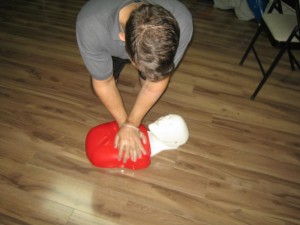The concept of basic life support has been around since the 1700s. It basically sets out to set a streamlined step-by-step approach in rescuing victims of cardiopulmonary arrest. The official BLS guidelins were coined by the American Heart Association in the 1990s, setting international standards for cardiac care, along with their more complex Advanced Life Support (ALS) guidelines. With over 6 providers in 6 cities over 4 states, our BLS programs are the best you will find in the country. Beyond quality training content, all our classes are taught by certified instructors and offer flexible schedules for trainees. There are three total BLS programs available in all our providers.
What are BLS guidelines?
The latest BLS guidelines were released by the AHA in 2010. They cover the basic technique updates when giving CPR, as well as a more comprehensive steps in rescuing a victim of cardiac arrest. These steps are referred to as the “chain of survival”. It is composed of five “links” or steps. These steps have been used in studies with very positive results – a marked improvement in the survival rate of victims.
The Chain of Survival

- Recognizing cardiac arrest and calling for emergency medical attention (911)
- Starting chest compressions and rescue breathing
- Rapid defibrillation
- ALS
- Post-cardiac care
The third step is usually done by EMTs once an ambulance arrives. The last two steps are are typically done in an emergency room or in the ambulance on the way to the nearest hospital or medical facility. These 5 steps are equally important in learning Basic Life Support and actually doing them to help other people.
How many BLS programs are there?
We offer three programs under the BLS umbrella. The first two – Heartsaver CPR and Heartsaver CPR (C) – have the same curriculum that focuses on one-person rescue. The use of defibrillators and basic first aid skills are also part of the program’s curriculum. Heartsaver CPR is for the general public and has an optional skills test to become a certified rescue. Heartsaver CPR (C) is for healthcare providers and students. A mandatory test (practical and written) is given at the end of training.
The last program – BLS for HCPs – focuses on one and two-person rescue, aside from AED and first aid training. This program is tailored for healthcare providers or students who are studying healthcare. The main part of this program is introducing rescuers to the latest BLS guidelines from the AHA. Students need to pass a pre-test in order to sign up for this program. A practical and written test are given after the program to receive credentials.
- Heartsaver CPR – 4 hours
- Heartsaver CPR (C) – 4.5 hours
- BLS for HCPs – 4.5 hours (re-certification: 4 hours)
How often will I need to renew my credentials?
All certificates expire after two years. If you plan on renewing your certificate (only available for BLS for HCPs), be sure to do so before the expiration date. Expired certificates are not honored at any of our providers. You will need to take the full program if you let your credentials expire or sign up for re-certification after three years.
